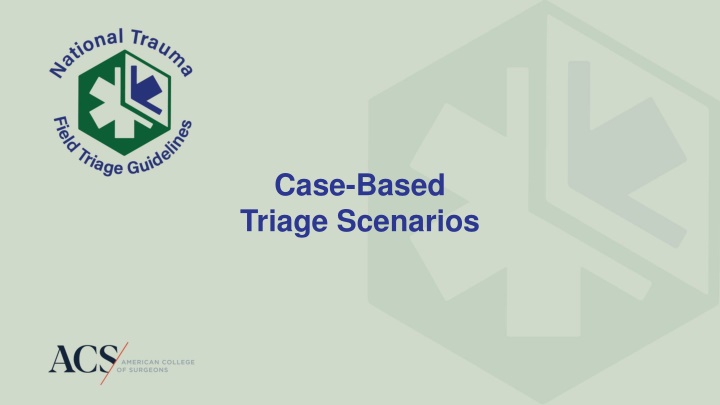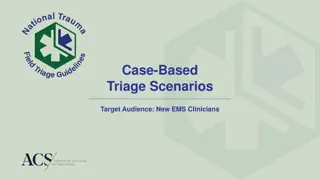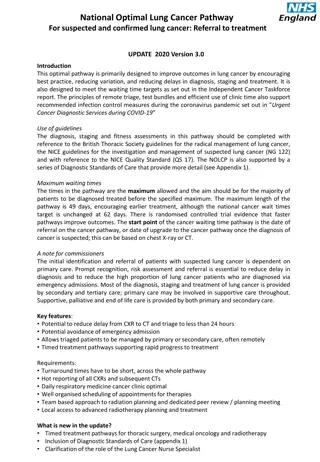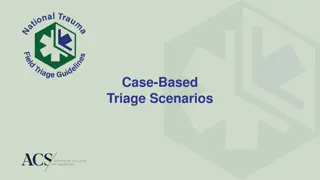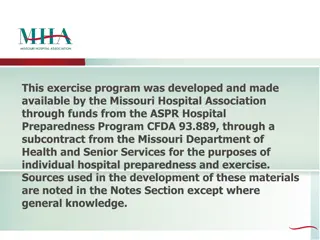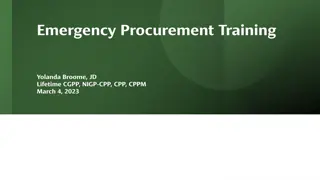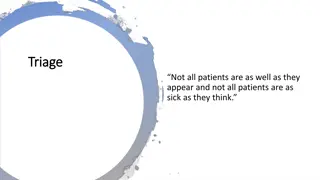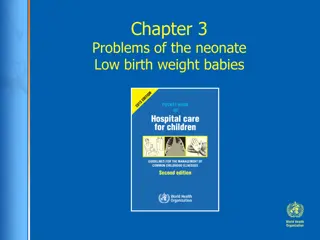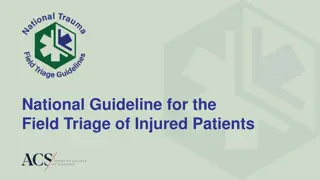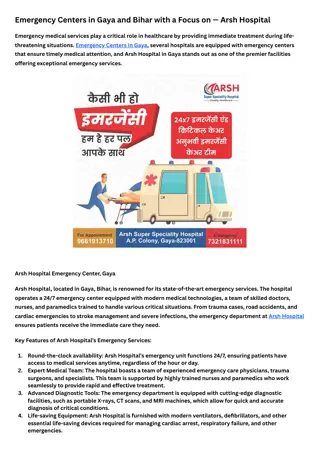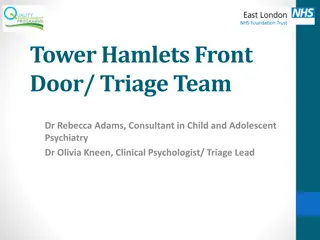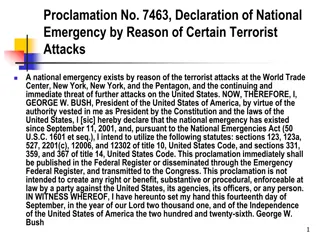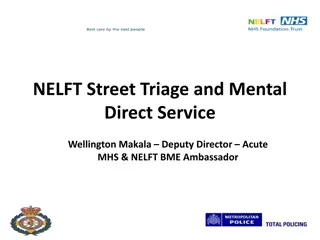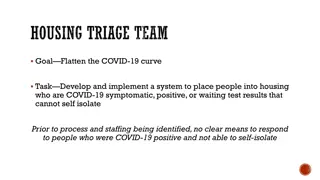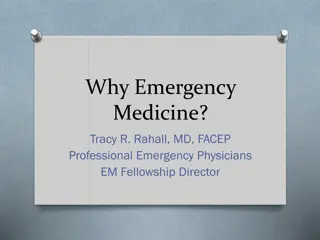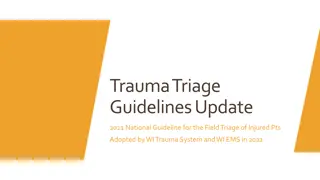Case-Based Triage Scenarios: Making Critical Decisions in Emergency Situations
Case-Based Triage Scenarios provide educational training tools for applying the National Guideline for Field Triage of Injured Patients. Each scenario presents a unique patient case for assessment and triage decision-making, emphasizing the importance of local trauma system resources and structure. With guidance from the best evidence available, healthcare professionals learn to identify patients who could benefit most from trauma center resources. These scenarios help practitioners enhance their ability to make timely and effective triage decisions in real-life emergency situations, considering factors such as patient destination, hospital bypassing, and transport mode.
Download Presentation

Please find below an Image/Link to download the presentation.
The content on the website is provided AS IS for your information and personal use only. It may not be sold, licensed, or shared on other websites without obtaining consent from the author.If you encounter any issues during the download, it is possible that the publisher has removed the file from their server.
You are allowed to download the files provided on this website for personal or commercial use, subject to the condition that they are used lawfully. All files are the property of their respective owners.
The content on the website is provided AS IS for your information and personal use only. It may not be sold, licensed, or shared on other websites without obtaining consent from the author.
E N D
Presentation Transcript
Case-Based Triage Scenarios
These case-based scenarios have been developed as an educational training tool to illustrate application of the National Guideline for the Field Triage of Injured Patients. EMS and trauma systems vary significantly across the US. Consider your own specific circumstances throughout these cases to help you make timely triage decisions in real-life about patient destination, bypassing other hospitals, and transport mode.
In each scenario there will be one patient to assess and make a triage decision. The Field Triage Guideline was developed using the best available evidence to identify patients that are most likely to benefit from the resources of a trauma center. They are not meant to supersede local trauma triage protocols and are not intended for mass casualty incident (MCI) triage.
What are the resources and structure of your local trauma system? Trauma centers of each level and transport time/distance Local non-trauma center hospitals Air medical services and time to request & arrive on scene Other ambulance coverage & need for mutual aid Geographic constraints or other unique resources and challenges
CASE 1 Dispatch Info: Passenger vehicle rear-end collision into Garbage truck, unknown injuries. Scene Size Up: SUV with damage as shown. Middle-aged male driver restrained, still in vehicle. Primary survey: A Answering your questions when you approach B Regular, non-labored C Rapid radial pulse, cool skin D Following commands, confused about where he is & what happened Secondary survey: Exam Scattered facial abrasions, abdomen tender lower quadrants, seat-belt sign across lower abdomen, swollen & tender left knee/shin Initial vital signs BP 96/52 HR 124 RR 20 SpO2 97% RA GCS 14 (E4 V4 M6) History HTN, on anti-HTN medication Source: Joshua Brown, MD MSc FACS. Used with permission Initial Thoughts?
CASE 1 Dispatch Info: Passenger vehicle rear-end collision into Garbage truck, unknown injuries. Scene Size Up: SUV with damage as shown. Middle-aged male driver restrained, still in vehicle. Primary Survey: A Answering your questions when you approach B Regular, non-labored C Rapid radial pulse, cool skin D Following commands, confused about where he is & what happened Secondary survey: Exam Scattered facial abrasions, abdomen tender lower quadrants, seat-belt sign across lower abdomen, swollen & tender left knee/shin Initial vital signs BP 96/52 HR 124 RR 20 SpO2 97% RA GCS 14 (E4 V4 M6) Source: Joshua Brown, MD MSc FACS. Used with permission History HTN, on anti-HTN medication Patient Destination?
CASE 1 Dispatch Info: Passenger vehicle rear-end collision into Garbage truck, unknown injuries. Scene Size Up: SUV with damage as shown. Middle-aged male driver restrained, still in vehicle. Primary Survey: A Answering your questions when you approach B Regular, non-labored C Rapid radial pulse, cool skin D Following commands, confused about where he is & what happened Secondary Survey: Exam Scattered facial abrasions, abdomen tender lower quadrants, seat-belt sign across lower abdomen, swollen & tender left knee/shin Initial vital signs BP 96/52 HR 124 RR 20 SpO2 97% RA GCS M 6 History HTN, on anti-HTN medication Source: Joshua Brown, MD MSc FACS. Used with permission Changes to Your Plan?
CASE 2A Dispatch Info: Two-car MVC, one car over embankment, possible injuries. You and a second unit are dispatched. Scene Size Up: Sedan over embankment, damage as shown. Young female restrained driver responding but confined by damaged door. Air bags deployed. Door is popped by rescue & patient able to self-extricate. Primary survey: A Yelling for help, answers questions B Regular, non-labored C Regular radial pulse, warm skin D Following commands, agitated about wreck Secondary survey: Exam Scattered small facial & arm lacs from glass, obviously deformed right shin with bruising Initial vital signs BP 112/68 HR 96 RR 18 SpO2 99% RA GCS 15 Initial Thoughts? Source: Mark Gestring, MD FACS. Used with permission
CASE 2A Dispatch Info: Two-car MVC, one car over embankment, possible injuries. You and a second unit are dispatched. Scene Size Up: Sedan over embankment, damage as shown. Young female restrained driver responding but confined by damaged door. Air bags deployed. Door is popped by rescue & patient able to self-extricate. Primary Survey: A Yelling for help, answers questions B Regular, non-labored C Regular radial pulse, warm skin D Following commands, agitated about wreck Secondary survey: Exam Scattered small facial & arm lacs from glass, obviously deformed right shin with bruising Initial vital signs BP 112/68 HR 96 RR 18 SpO2 99% RA GCS 15 History None Source: Mark Gestring, MD FACS. Used with permission Patient Destination?
CASE 2A Dispatch Info: Two-car MVC, one car over embankment, possible injuries. You and a second unit are dispatched. Scene Size Up: Sedan over embankment, damage as shown. Young female restrained driver responding but confined by damaged door. Air bags deployed. Door is popped by rescue & patient able to self-extricate. Primary Survey: A Yelling for help, answers questions B Regular, non-labored C Regular radial pulse, warm skin D Following commands, agitated about wreck Secondary Survey: Exam Scattered small facial & arm lacs from glass, bilateral shins with bruising Initial vital signs BP 112/68 HR 96 RR 18 SpO2 99% RA GCS M 6 History None Source: Mark Gestring, MD FACS. Used with permission Changes to Your Plan?
CASE 2B Dispatch Info: Two-car MVC, one car over embankment, possible injuries. You and a second unit are dispatched. Scene Size Up: Sedan over embankment resting on side as shown. Young female restrained driver responding but lower extremities entrapped under dash. Rescue removes the roof and performs dash roll to extricate patient, takes ~25 minutes to get patient out. Primary survey: A Yelling for help, answers questions B Regular, non-labored C Regular radial pulse, warm skin D Following commands, agitated about wreck Exam Scattered small facial & arm lacs from glass, obviously deformed right shin with bruising Initial vital signs BP 112/68 HR 96 RR 18 SpO2 99% RA GCS 15 History None Initial Thoughts? Source: Mark Gestring, MD FACS. Used with permission
CASE 2B Dispatch Info: Two-car MVC, one car over embankment, possible injuries. You and a second unit are dispatched. Scene Size Up: Sedan over embankment resting on side as shown. Young female restrained driver responding but lower extremities entrapped under dash. Rescue removes the roof and performs dash roll to extricate patient, takes ~25 minutes to get patient out. Primary Survey: A Yelling for help, answers questions B Regular, non-labored C Regular radial pulse, warm skin D Following commands, agitated about wreck Secondary surve Source: Mark Gestring, MD FACS. Used with permission y: facial & arm lacs from glass, obviously deformed right shin with bruising Initial vital signs BP 112/68 HR 96 RR 18 SpO2 99% RA GCS 15 History None Patient Destination?
CASE 2B Dispatch Info: Two-car MVC, one car over embankment, possible injuries. You and a second unit are dispatched. Scene Size Up: Sedan over embankment resting on side as shown. Young female restrained driver responding but lower extremities entrapped under dash. Rescue removes the roof and performs dash roll to extricate patient, takes ~25 minutes to get patient out. Primary Survey: A Yelling for help, answers questions B Regular, non-labored C Regular radial pulse, warm skin D Following commands, agitated about wreck Secondary Survey: Exam Scattered small facial & arm lacs from glass, bilateral shins with bruising Initial vital signs BP 112/68 HR 96 RR 18 SpO2 99% RA GCS M 6 History None Source: Mark Gestring, MD FACS. Used with permission Changes to Your Plan?
CASE 3 Dispatch Info: Young female fell while standing on a chair, significant bleeding reported from leg wound. Scene Size Up: Family home, around in back yard you find overturned chair & shattered glass table. There s a large amount of blood on ground and patient. Family is holding bloody towel on left leg. Primary survey: A Able to answer questions B Regular, non-labored C Mildly diaphoretic, palpable radial pulse in both arms D Following commands, alert and oriented Secondary survey: Exam Multiple deep lacerations to the right upper arm and forearm, down to muscle. One laceration has spurting blood when removing the towel bystanders are using, HTN, HLD. No anticoagulant meds, baby aspirin Source: American College of Surgeons. Used with permission Initial Thoughts?
CASE 3 Dispatch Info: Young female fell while standing on a chair, significant bleeding reported from leg wound. Scene Size Up: Family home, around in back yard you find overturned chair & shattered glass table. There s a large amount of blood on ground and patient. Family is holding bloody towel on left leg. Primary Survey: A Able to answer questions B Regular, non-labored C Mildly diaphoretic, palpable radial pulse in both arms D Following commands, alert and oriented. States she fell off a chair onto a glass table. Source: American College of Surgeons. Used with permission Secondary surve y: Exam Multiple deep lacerations to the right upper arm and forearm, down to mt slows the bleeding. Initial vital sign s BP 110/72 CAD, DM, HTN, HLD. No anticoagulant meds, baby aspirin Patient Destination?
CASE 3 Dispatch Info: Young female fell while standing on a chair, significant bleeding reported from leg wound. Scene Size Up: Family home, around in back yard you find overturned chair & shattered glass table. There s a large amount of blood on ground and patient. Family is holding bloody towel on left leg. Primary Survey: A Able to answer questions B Regular, non-labored C Mildly diaphoretic, palpable radial pulse in both arms D Following commands, alert and oriented. States she fell off a chair onto a glass table. Secondary Survey: Exam Long deep laceration lateral left calf, down to muscle. Spurting blood when removing the towel bystanders are using for pressure. You place a commercial tourniquet that stops the bleeding. Initial vital signs BP 110/72 HR 102 RR 12 SpO2 98% RA GCS M 6 History None Source: American College of Surgeons. Used with permission Changes to Your Plan?
CASE 4A Dispatch Info: Elderly male ground level fall. Scene Size Up: Elderly male lying on ground with cane nearby. Lives alone. Primary survey: A Answers questions B Regular, non-labored C Regular radial pulse, warm skin D Following commands, oriented, states he tripped when was not using his walker Secondary survey: Exam Small skin tear on left hand not bleeding, no obvious head trauma, patient unsure if he hit his head Initial vital signs BP 168/84 HR 84 RR 12 SpO2 96% RA GCS 15 History CAD, HTN, OA. No anticoagulants o antiplatelets Source: Getty Images. Used with permission Initial Thoughts?
CASE 4A Dispatch Info: Elderly male ground level fall. Scene Size Up: Elderly male lying on ground with cane nearby. Lives alone. Primary Survey: A Answers questions B Regular, non-labored C Regular radial pulse, warm skin D Following commands, oriented, states he tripped Source: Getty Images. Used with permission Secondary survey: Exam Small skin tear on left hand not bleeding, no obvious head trauma, patient unsure if he hit his head Initial vital signs BP 168/84 HR 84 RR 12 SpO2 96% RA GCS 15 History CAD, HTN, OA. No anticoagulants or antiplatelets Patient Destination?
CASE 4A Dispatch Info: Elderly male ground level fall. Scene Size Up: Elderly male lying on ground with cane nearby. Lives alone. Primary Survey: A Answers questions B Regular, non-labored C Regular radial pulse, warm skin D Following commands, oriented, states he tripped Source: Getty Images. Used with permission Secondary Survey: Exam Small skin tear on left hand not bleeding, no obvious head trauma, patient unsure if he hit his head Initial vital signs BP 168/84 HR 84 RR 12 SpO2 96% RA GCS M 6 History CAD, HTN, OA. No anticoagulants or antiplatelets Changes to Your Plan?
CASE 4B Dispatch Info: Elderly male ground level fall. Scene Size Up: Elderly male lying on ground near couch. Lives alone. Primary survey: A Answers questions B Regular, non-labored C Regular radial pulse, warm skin D Following commands, oriented to person, place. States he tripped on rug Secondary survey: Exam Large hematoma on left forehead with small overlying skin tear. Multiple bruises on both arms, some appear old. Initial vital signs BP 168/84 HR 84 RR 12 SpO2 96% RA GCS 15 History CAD, HTN, OA, afib. On warfarin (Coumadin) Source: Getty Images. Used with permission Initial Thoughts?
CASE 4B Dispatch Info: Elderly male ground level fall. Scene Size Up: Elderly male lying on ground near couch. Lives alone. Primary Survey: A Answers questions B Regular, non-labored C Regular radial pulse, warm skin D Following commands, oriented to person, place. States he tripped on rug Source: Getty Images. Used with permission Secondary survey: Exam Large hematoma on left forehead with small overlying skin tear. Multiple bruises on both arms, some appear old. Initial vital signs BP 168/84 HR 84 RR 12 SpO2 96% RA GCS 15 History CAD, HTN, OA, afib. On warfarin (Coumadin) Patient Destination?
CASE 4B Dispatch Info: Elderly male ground level fall. Scene Size Up: Elderly male lying on ground near couch. Lives alone. Primary Survey: A Answers questions B Regular, non-labored C Regular radial pulse, warm skin D Following commands, oriented to person, place. States he tripped on rug Source: Getty Images. Used with permission Secondary Survey: Exam Large hematoma on left forehead with small overlying skin tear. Multiple bruises on both arms, some appear old. Initial vital signs BP 168/84 HR 84 RR 12 SpO2 96% RA GCS M 6 History CAD, HTN, OA, afib. On warfarin (Coumadin) Changes to Your Plan?
CASE 5A Dispatch Info: Single car MVC, side impact into telephone pole. Scene Size Up: Driver still in car. Damage as shown. He was not wearing a seatbelt. Source: Mark Gestring, MD FACS. Used with permission Initial Thoughts?
CASE 5A Dispatch Info: Single car MVC, side impact into telephone pole. Scene Size Up: Driver still in car. Damage as shown. He was not wearing a seatbelt. Primary Survey: A Responding to questions B Regular, non-labored respirations C Radial pulses strong, rapid rate D Alert, obeys commands, denies any LOC Source: Mark Gestring, MD FACS. Used with permission Patient Destination?
CASE 5A Dispatch Info: Single car MVC, side impact into telephone pole. Scene Size Up: Driver still in car. Damage as shown. He was not wearing a seatbelt. Primary Survey: A Responding to questions B Regular, non-labored respirations C Radial pulses strong, rapid rate D Alert, obeys commands, denies any LOC Secondary Survey: Exam Contusion to left parietal area. Denies pain in neck, chest, abdomen, and moving all extremities, except LLE. Deformities noted in left ankle and foot. Initial vital signs BP 162/124 HR 114 RR 26 SpO2 95% RA History HTN, DM Source: Mark Gestring, MD FACS. Used with permission GCS M 6 Changes to Your Plan?
CASE 5B Dispatch Info: Single car MVC, side impact into telephone pole. Scene Size Up: Driver out standing by car. Rear right side passenger still in car. Damage as shown. Passenger was not wearing a seatbelt. Source: Mark Gestring, MD FACS. Used with permission Initial Thoughts?
CASE 5B Dispatch info: Single car MVC, side impact into telephone pole. Scene size up: Driver out standing by car. Rear right side passenger still in car. Damage as shown. Passenger was not wearing a seatbelt. Primary survey: A Responding to questions B Regular, non-labored respirations C Radial pulses strong, rapid rate D Alert, obeys commands, denies any LOC Source: Mark Gestring, MD FACS. Used with permission Patient Destination?
CASE 5B Dispatch info: Single car MVC, side impact into telephone pole. Scene size up: Driver out standing by car. Rear right side passenger still in car. Damage as shown. Passenger was not wearing a seatbelt. Primary survey: A Responding to questions B Regular, non-labored respirations C Radial pulses strong, rapid rate D Alert, obeys commands, denies any LOC Source: Mark Gestring, MD FACS. Used with permission Secondary Survey: Exam Contusion to left parietal area, Denies pain in neck, chest, abdomen, and moving all extremities, except LLE. Deformities noted in left ankle and foot. Initial vital signs BP 162/124 HR 114 RR 26 SpO2 95% RA GCS M 6 History HTN, DM Changes to Your Plan?
CASE 5C Dispatch Info: Single car MVC, side impact into telephone pole. Scene Size Up: Pregnant female driver still in car. Damage as shown. She was not wearing a seatbelt. Source: Mark Gestring, MD FACS. Used with permission Initial Thoughts?
CASE 5C Dispatch Info: Single car MVC, side impact into telephone pole. Scene Size Up: Pregnant female driver still in car. Damage as shown. She was not wearing a seatbelt. Primary Survey: A Responding to questions B Breathing non labored but rapid C No signs of bleeding, pulse rapid D Alert, obeys commands, denies any LOC Source: Mark Gestring, MD FACS. Used with permission Patient Destination?
CASE 5C Dispatch Info: Single car MVC, side impact into telephone pole. Scene Size Up: Pregnant female driver still in car. Damage as shown. She was not wearing a seatbelt. Primary Survey: A Responding to questions B Breathing non labored but rapid C No signs of bleeding, pulse rapid D Alert, obeys commands, denies any LOC Secondary Survey: Exam Abdomen has large bruise to the left upper quadrant, size of baseball, tender on palpation. Uterus is firm at fundal height. Initial vital signs BP 114/52 HR 111 RR 28 SpO2 98% RA GCS M 6 History She is 29 weeks pregnant, gravida 1, para 0 Source: Mark Gestring, MD FACS. Used with permission Changes to Your Plan?
CASE 6 Dispatch Info: Male fell off ladder. Scene Size Up: Middle aged male lying on his back on concrete driveway, ladder lying next to him near 2 story roof. He s alert and responsive. Source: Getty Images. Used with permission Initial Thoughts?
CASE 6 Dispatch Info: Male fell off ladder. Scene Size Up: Middle aged male lying on his back on concrete driveway, ladder lying next to him near 2 story roof. He s alert and responsive. Primary Survey: A Answers questions B Regular, non-labored C Regular radial pulse, warm skin D Following commands. States up working on roof eaves and ladder gave out. Source: Getty Images. Used with permission Patient Destination?
CASE 6 Dispatch Info: Male fell off ladder. Scene Size Up: Middle aged male lying on his back on concrete driveway, ladder lying next to him near 2 story roof. He s alert and responsive. Primary Survey: A Answers questions B Regular, non-labored C Regular radial pulse, warm skin D Following commands. States up working on roof eaves and ladder gave out. Secondary Survey: Exam Hematoma to occiput. Cannot move lower extremities, states they are numb. Full strength in upper extremities. No obvious lower extremity deformities. Initial vital BP 152/110 HR 70 RR 22 SpO2 98% RA GCS M 6 History HTN, CAD, CABGx2 Source: Getty Images. Used with permission Changes to Your Plan?
